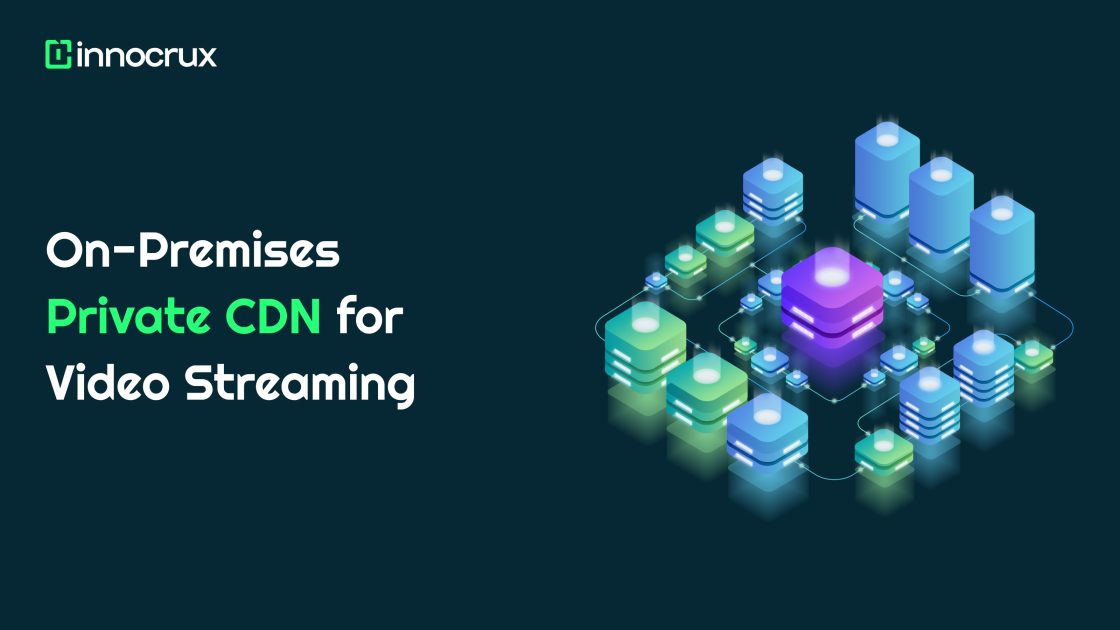Introduction
As video content continues to dominate internet traffic, content providers need efficient and scalable solutions to deliver high-quality video experiences to users worldwide. Traditional public CDNs might not always meet specific needs for privacy, control, or cost-effectiveness, leading many organizations to explore private CDN solutions. Innocrux, a leading video streaming solution provider, offers comprehensive services to set up and manage a private CDN tailored to your specific requirements.
What is CDN in Video Streaming?
Content Delivery Network (CDN) video streaming refers to the process of delivering video content over the internet using a network of geographically distributed servers. This network, known as a CDN, is designed to efficiently deliver video content to end-users by reducing latency, improving load times, and enhancing overall performance.
How does CDN work in Video Streaming?
- Content Distribution:Video content is uploaded to origin servers, where it is stored and managed.
- Replication and Caching:The CDN replicates the video content across multiple edge servers located in various geographic regions. These edge servers cache the content locally, closer to the end-users.
- User Requests:When a user requests to view a video, the CDN routes the request to the nearest edge server based on the user’s location.
- Content Delivery:The edge server delivers the video content to the user’s device, ensuring fast and reliable streaming.

Benefits of Content Delivery Network:
- Improved Performance: CDN video streaming reduces buffering and load times, providing users with a smoother and more seamless viewing experience.
- Scalability:CDNs can handle high volumes of traffic and scale dynamically to accommodate spikes in demand, ensuring consistent performance during peak periods.
- Global Reach:By distributing content across multiple edge servers worldwide, CDN video streaming enables content providers to reach a global audience with minimal latency.
- Enhanced Reliability:CDNs offer redundancy and failover mechanisms, ensuring uninterrupted video streaming even in the event of server failures or network disruptions.
- Bandwidth Optimization:CDN video streaming reduces bandwidth consumption on origin servers by serving content from edge caches, resulting in cost savings and improved network efficiency.
- Security:CDNs implement security features such as encryption, access controls, and DDoS protection to safeguard video content and user data from unauthorized access and cyber threats.
In summary, CDN video streaming revolutionizes the way video content is delivered over the internet, offering unparalleled performance, scalability, and reliability for content providers and viewers alike.
Challenges with Cloud CDNs and When to Consider a Private CDN
While cloud-based CDNs offer many advantages, they may not always be the best fit for every organization. Here are some common challenges associated with cloud CDNs and scenarios where a private CDN might be more suitable:
- Cost Control – Cloud CDNs often charge based on usage, which can lead to unpredictable costs. High traffic volumes can result in substantial expenses, making budgeting difficult.
- Limited Control – Organizations may have limited control over the infrastructure and configuration of cloud CDNs. This can restrict the ability to customize settings to meet specific requirements.
- Data Privacy and Security – Storing and transmitting data through third-party networks may raise privacy and security concerns, especially for sensitive or proprietary content.
- Performance Variability: – Cloud CDNs can suffer from performance variability due to shared infrastructure and varying traffic loads from other users.
- Dependency on External Providers – Relying on third-party providers can introduce risks related to service outages, changes in service terms, or provider stability.
When to Consider a Private CDN
- Predictable and Controlled Costs – For organizations with high or variable traffic volumes, a private CDN can provide more predictable and controlled costs compared to usage-based cloud CDNs.
- Enhanced Control and Customization – Organizations that require specific configurations, custom routing, or tailored caching strategies benefit from the enhanced control provided by a private CDN.
- Data Privacy and Compliance – A private CDN ensures that all data remains within the organization’s infrastructure, reducing risks associated with data breaches and compliance with regulations like GDPR or HIPAA.
- Consistent Performance – By deploying a private CDN, organizations can achieve consistent performance by optimizing the network infrastructure for their specific content and audience.
- Reliability and Redundancy – A private CDN allows organizations to build a redundant and resilient infrastructure, minimizing the risk of service disruptions and ensuring high availability.
Key Features of Innocrux’s Private CDN Solutions
Innocrux’s private CDN solutions offer a comprehensive set of features designed to address the evolving needs of content providers and ensure seamless delivery of video content to users worldwide. Beyond the essential functionalities, Innocrux incorporates advanced capabilities to optimize performance, enhance security, and provide scalability. Here are some additional features:
- Reduced Latency:Innocrux’s solutions ensure that caches are located close to the end users, reducing the round-trip time for content delivery and enhancing user experience.
- Reduced Bandwidth Costs:By storing content in strategic locations, Innocrux helps minimize the load on origin servers and reduce bandwidth usage across bottleneck links.
- Improved Quality of Experience:Innocrux’s CDN solutions provide lower round-trip times and higher delivery bandwidth, directly translating to smoother, high-quality video streaming experiences.
- Custom Edge Rules:Configure custom edge rules to control how content is cached, delivered, and protected at the edge. Fine-tune caching policies, URL routing, and content manipulation to optimize delivery performance and meet specific business requirements.
- Real-Time Analytics:Gain deep insights into CDN performance, user engagement, and content consumption patterns with real-time analytics. Monitor key metrics such as bandwidth usage, cache hit ratio, and user geolocation to make data-driven decisions and optimize content delivery strategies.
- Dynamic Content Packaging:Dynamically package and deliver video content in multiple formats and bitrates to accommodate diverse device capabilities and network conditions. Implement adaptive bitrate streaming (ABR) to deliver the best possible viewing experience across different devices and network speeds.
- Content Security Policies: Enforce content security policies to protect against common web threats and vulnerabilities. Implement security headers, cross-site scripting (XSS) protection, and content security policies (CSP) to mitigate risks associated with malicious content injection and unauthorized data access.
- Multi-CDN Integration: Integrate multiple CDN providers seamlessly to leverage their combined strengths and ensure optimal content delivery performance. Implement multi-CDN failover and load balancing strategies to switch between CDN providers dynamically based on performance metrics and availability.
- API-driven Configuration:Manage and configure the private CDN infrastructure programmatically using RESTful APIs and automation tools. Enable seamless integration with existing workflows, provisioning systems, and DevOps toolchains to streamline deployment, configuration, and maintenance tasks.
- Advanced Security Features:Implement advanced security features such as DDoS protection, Web Application Firewall (WAF), and bot mitigation to safeguard against emerging threats and attacks. Utilize anomaly detection, rate limiting, and threat intelligence to identify and mitigate malicious traffic in real-time.

By integrating these advanced features into its private CDN solutions, Innocrux empowers content providers to build high-performance, secure, and scalable OTT video streaming platforms, delivering exceptional experiences to users worldwide.Whether delivering live events, on-demand content, or interactive media experiences, Innocrux’s private CDN solutions provide the flexibility, reliability, and control needed to succeed in today’s digital landscape.
Prerequisites for Setting Up a Private CDN with Innocrux
Before setting up a private CDN with Innocrux, certain decisions and preparations need to be made:
- Domain Name for the CDN:This is the primary domain through which the CDN will serve content.
- Domain Name for the CDN Infrastructure:This can be the same as the CDN domain or a different one, used for managing the CDN components.
- Host Names:Specific host names for the servers where Innocrux components will be installed.
- Admin User Name and Password: Credentials for the administrative user managing the CDN.
- Vault User Name and Password:Credentials for the secure storage service used by Innocrux.
These details will be required during various stages of the installation process. Consistency is crucial to avoid configuration issues.
While it is possible to customize the installation paths and user names, it is generally recommended to use the default paths and default user names provided by Innocrux. Customizing these settings involves significant effort with minimal benefit, so sticking to the defaults simplifies the installation and maintenance process.
Core Components and Configuration Details
Delve into the foundational elements and crucial setup details necessary for building a robust private CDN infrastructure optimized for video streaming.
Regional Edge Locations and Synchronization
- Multiple Locations:Deploy caches in multiple geographical regions to ensure content is delivered from the nearest possible location, reducing latency.
- Synchronization:Innocrux’s solution ensures that content is synchronized across all edge locations. Updates to the content are propagated efficiently to maintain consistency.
Invalidation and Cache Time
- Cache Invalidation:Implement cache invalidation strategies to ensure that outdated content is removed promptly. This can be done manually or automatically based on rules and triggers.
- Cache Time: Configure TTL (Time-to-Live) settings for cached content to balance between freshness and performance. Different content types can have different cache times.
CORS Rules and Header Requests
- CORS (Cross-Origin Resource Sharing):Define CORS policies to control how resources on your server can be requested from another domain, improving security and interoperability.
- Header Requests:Customize HTTP headers for requests and responses to enhance security, manage caching behavior, and include additional metadata.
Domain Name Configuration
- Domain Name:Configure your CDN to serve content through your chosen domain name. This includes setting up DNS records and ensuring SSL/TLS certificates are in place for secure content delivery.
S3/Minio Integration and Origin Server
- S3/Minio Integration:Integrate with S3-compatible storage solutions like AWS S3 or Minio for reliable, scalable storage of your video content.
- Origin Server:Configure the origin server where your primary content resides. The CDN will fetch content from this server when it is not available in the cache.
Domain Name Configuration and Response-Time Based Routing
One of the crucial aspects of a private CDN setup is the configuration of the domain name and the implementation of response-time-based routing to ensure efficient content delivery. Here’s how Innocrux addresses these components:
Domain Name Configuration
- Primary Domain:Choose a primary domain name for your CDN, which will be used to serve content. This domain should be easy to remember and relevant to your brand or content type.
- Infrastructure Domain:Optionally, you can use a separate domain for managing CDN infrastructure. This can help in organizing and securing the management interfaces and APIs.
- DNS Setup:Proper DNS configuration is essential to direct traffic to the CDN. Innocrux assists in setting up DNS records such as A, AAAA, and CNAME to point to the appropriate edge servers.
- SSL/TLS Certificates:Secure your domain with SSL/TLS certificates to ensure encrypted content delivery, protecting user data and enhancing trust.
Response-Time Based Routing
Innocrux employs advanced routing techniques to optimize content delivery based on response times:
- Latency Measurement:Continuously monitor the response times from various edge locations to different user regions.
- Dynamic Routing:Use real-time data to dynamically route user requests to the edge server with the lowest response time. This ensures that content is delivered quickly and efficiently.
- Load Balancing:Distribute traffic evenly across multiple edge servers to prevent overloading and maintain optimal performance.
- Geographic Proximity:Implement geo-routing to direct user requests to the nearest edge server, further reducing latency and improving user experience.
Innocrux elevates VOD, OTT, and live streaming delivery with our tailored private CDN solutions, ensuring seamless content distribution on-premises with unmatched reliability and performance.
-Innocrux
Conclusion
Innocrux offers a powerful solution for organizations looking to build a private CDN for video content delivery. Its robust features, comprehensive services, and industry expertise make it an ideal choice for ensuring high-quality, efficient, and scalable video streaming experiences. As video demand continues to grow, adopting a private CDN with Innocrux can help content providers meet user expectations while maintaining control over their delivery infrastructure.








No comments yet